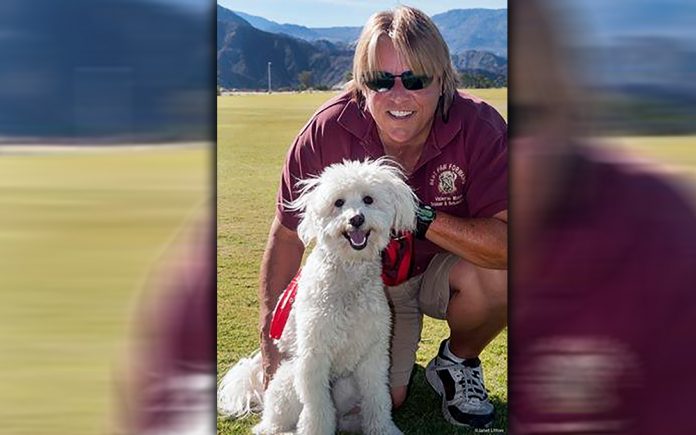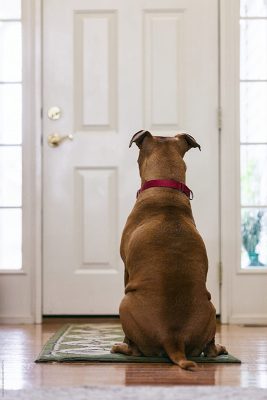
By Janet McAfee
Recent news reports showed rows of empty kennels at animal shelters. Those kennels tell the story of happy endings for homeless animals adopted by homebound Americans seeking pet companionship during the pandemic. Now as California begins to reopen some businesses and work places, many of those adopters are heading back to work. Most of these rescue pups have the confidence to easily adapt when the stay-at-home order lifts and their humans are suddenly away from home for 9 hours. What can you do now to ensure your recently adopted dog has a smooth transition to this change? The dog you’ve had for years may also be a bit sad when you are not with him all day.
 We consulted with Valerie Masi, local dog trainer and operator of Best Paw Forward, for some expert advice. She advises, “If folks know they are returning to work soon, they can start now putting the dog on that schedule. Walk them in the morning, and I don’t mean a 15 minute walk. They need a 30 minute to a 1 hour walk, depending on the breed. Walk the dog with structure (heel position) which increases their self-control as well as working them mentally. When we humans have mental workout days we are far more tired than physical days and it’s the same for dogs. When a dog walks all over the place, stopping constantly and pulling, they are staying in an excited state of mind.”
We consulted with Valerie Masi, local dog trainer and operator of Best Paw Forward, for some expert advice. She advises, “If folks know they are returning to work soon, they can start now putting the dog on that schedule. Walk them in the morning, and I don’t mean a 15 minute walk. They need a 30 minute to a 1 hour walk, depending on the breed. Walk the dog with structure (heel position) which increases their self-control as well as working them mentally. When we humans have mental workout days we are far more tired than physical days and it’s the same for dogs. When a dog walks all over the place, stopping constantly and pulling, they are staying in an excited state of mind.”
Valerie describes her experience with canine separation anxiety that occurred with her personal dog, Duke. In 1991, she took this German shepherd puppy with her while she attended the National k-9 School of Dog Training, a 4-month residential program in Columbus, Ohio. Ironically, the school never covered the topic of separation anxiety. Valerie recalls, “When we returned home, Duke didn’t know how to be calm when I left the house after being with me all day long. He started to destroy things in the home. He even escaped from a secured crate. Dogs can only learn if they experience something, and he needed to learn how to be calm. Back then the vets didn’t have anxiety medication, so I put Duke on a tranquilizer, just enough to keep him calm, and soon weened him off once he learned that state of mind.”
Valerie continues with great advice for dog owners, “Provide your dog with some ‘high value’ items when you leave, such as the frozen bones you can purchase at pet specialty shops. Nyla bones and favorite toys are also effective to keep their attention. Start leaving them alone the first time for a few hours in a crate in another room. The crate must be large enough for the dog to stand and move around. Once they are calm consistently, start leaving the house adding more time away.”
“If they have an issue, they will usually act out right after their human leaves, with the length of time depending on the dog. Consider placing them in a doggie day care program where they can enjoy the company of other pups a couple days a week. When you do leave them alone at home, make sure they get exercised beforehand, and they might chose to nap when you leave. A tired contented dog that had a brisk walk and playtime is more likely to be calm when you go out.”
House training is another important issue when you are not available for those frequent potty visits outside. With tough cases, you can house your pup in a tiled bathroom or kitchen with a baby gate keeping them enclosed. Small artificial grass patches with a catch tray beneath them are available at PetSmart and Petco. Valerie suggests that doggie doors with x-pens might work for medium or small dogs (as long as your yard is secure from coyotes).
Lillian Roberts, D.V.M, veterinarian at Country Club Animal Clinic in Palm Desert, advises, “We don’t know what it’s like for a dog when their whole world goes topsy turvy and suddenly you are gone from the home. They are pack animals, and instinctively want to be with people. Teach them in advance to be without you. If there are two people in the household, have each spend time separately with the dog. In severe cases, I prescribe special dog anti-anxiety medication or dog anti-depressants with the goal of weaning them off. In many cases, a dog trainer can help.”
Valerie is pictured here with Brandon (AKA Brian), a successful Loving All Animals alumni dog. Valerie donates her time to this animal welfare organization to help rescue dogs do well in their adoptive homes. In addition to certification from an accredited dog training school, Valerie Masi has a degree in Animal Behavior, Training, and Management from Moorpark College. This skilled dog trainer is adept at handling dogs of all sizes. You can contact Valerie Masi with Best Paws Forward for training assistance at (760) 885-9450.
Don’t give up on your special pup. Loving and loyal, our dogs help us get through the darkest of days. Remember, you are the center of your dog’s world, and he or she loves you more than you can imagine. There is almost no training problem that can’t be solved with some patience, skill, and time.











































